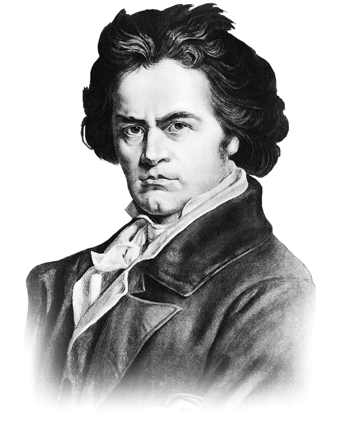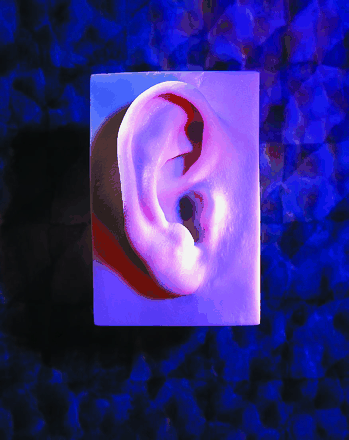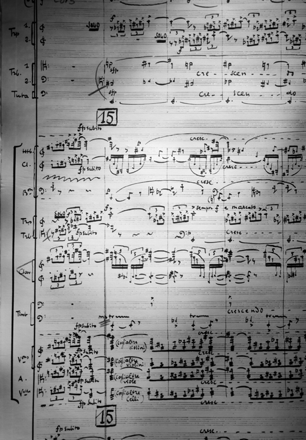Beethoven: A Life of Sound and Silence
Over twenty-three million Americans suffer from deafness, and over seven million from tinnitus, a continual ringing or buzzing in the ears that is not objectively measurable (1). Man is a social being, and deafness is an isolating disease. The socially disabling nature of deafness was aptly summarized by Helen Keller, who noted that, whereas blindness separates people from things, deafness separates people from people. Despite the social cost, however, hearing problems often lack the public recognition that blindness receives.

One major creative figure whose life was profoundly affected by hearing problems was the composer Ludwig van Beethoven. As with Milton's blindness, van Gogh's ear, and Toulouse-Lautrec's absinthism, the one thing everyone knows about Beethoven is his deafness. Beethoven did not become suddenly deaf, however. His deafness was a slow process, occupying over twenty years from the first hearing problems to total deafness.
Ludwig van Beethoven was born into a musical family in Bonn, Germany, in December 1770. His grandfather was Kapellmeister for the Elector of Cologne and his father was a tenor at the local court Kapelle. With the example of the young Mozart in mind, Beethoven's father relentlessly drove his son as a musical performer. As a child, Beethoven learned to play the organ, piano, violin, and viola. He gave his first public concert at the age of seven. At twelve years, he published his first composition.
Beethoven moved to Vienna in 1792 to take lessons from Joseph Haydn, and within a few years was renowned both as a composer and as a performer. Beethoven claimed he had had exceptionally keen hearing in early life. A loss of ability to hear high-pitched sounds, an indication of nerve deafness, first became apparent at the age of twenty-seven. By this age, he had written his First Symphony, the first two piano concertos, the piano trios of Opus 1 and Opus 11, the piano sonatas of Opus 13, the cello sonatas of Opus 5, and most of the work on the string quartets of Opus 18. He did not admit to his deafness for another three years. On June 29, 1801, he writes to Dr. Franz Wegeler in Bonn, “My hearing has grown steadily worse for three years…I was often in despair. To give you some idea of my extraordinary deafness, I must tell you that in the theater I am obliged to lean up close against the orchestra in order to understand the actors, and when a little way off I hear none of the high notes…Frequently, I can hear the sounds of a low conversation, but cannot make out the words” (2). Poor discrimination is classic for nerve deafness: Beethoven can hear, but not understand.
In the same letter, Beethoven refers to another phenomenon: “As soon as anybody shouts, I can't bear it. Heaven alone knows what is to become of me.” His response indicates he is suffering from hyperacusis, or a painful sensitivity to sounds. In deafness, the lower threshold for hearing is raised; sounds must be louder to be perceived comfortably. But the upper threshold for comfortable hearing for a person with hyperacusis may be lowered. Normal sounds ranging from beepers to coughs can be painful. For such a person, the sound intensity range in which hearing is clear and comfortable is compressed both at the upper end and at the lower.
Beethoven tells Wegeler that he leads a miserable life and for two years has avoided social functions because he finds it impossible to tell people that he is deaf. After all, he is a composer! Beethoven remarks on the general impercipience regarding hearing problems: “It is surprising that some people have never noticed my deafness.” A recent biographer writes that Beethoven's deafness led to “fear, lack of self-esteem, emotional disarray, increasing isolation, and self-neglect” (3).

Two days later, he writes to another friend, Carl Amenda, in Latvia, “My most prized possession, my hearing, has greatly deteriorated. When you were still with me, I already felt the symptoms but kept silent.” Thus, like many deaf people, he tried to hide the problem. Hearing loss began in the left ear, and spread to the right.
Deafness and hyperacusis were not his only problems. Beethoven also had tinnitus, complaining in 1801, “My ears whistle and buzz continually, day and night…such a condition is truly frightful.” In 1802, he moved from the noise of Vienna to the village of Heiligenstadt to help his hearing. There, he wrote the Second Symphony. At the end of six months, however, it was clear that his last hope of an improvement was illusory.
He then writes a testament in Heiligenstadt stating that his condition has driven him to despair and suicidal thoughts. Only morality and music keep him from killing himself. He complains that his hearing condition is hopeless, and although naturally sociable, that he has had to withdraw from society. “How could I possibly admit to an infirmity in that one sense which ought to be more perfect in me than in others, a sense which I once possessed in the highest perfection, a perfection such as few in my profession have or ever have had…. [The humiliation] drove me to despair…I would have ended my life. It was only my art that held me back.”
These early years of high anxiety for Beethoven were extremely productive musically. In 1800, he completed, among other works, the six string quartets of Opus 18, the First Symphony, and the Third Piano Concerto. In 1801, he wrote The Creatures of Prometheus, a string quintet, two violin sonatas, and four piano sonatas. This productivity has led biographers to suggest that his hearing crisis was necessary for his creativity, allowing him to listen to inner sounds without distraction. One biographer surmises that “deafness may have heightened his abilities as a composer…by permitting a total concentration within a world of increasing auditory seclusion” (4). He continues, “One begins to suspect that Beethoven's crisis and his extraordinary creativity were somehow related, and even that the former may have been the necessary precondition of the latter.” Another writes, “His deafness caused no tragic turn…it was, indeed, a definite aid that held him back from his worldly desires and kept his eye on his mission” (5).
Such suggestions are impercipient: hearing loss, and the associated tinnitus and hyperacusis, are handicaps, pure and simple. Beethoven's own words attest to the affliction with which he had to struggle. It is true, however, that Beethoven noted an alleviation of his affliction while he was composing, which may reflect a minimized consciousness of tinnitus during intense mental activity. One musical consequence of his deafness was a change in emphasis from performing and conducting to composing, to the cultural enrichment of subsequent generations. In his mid forties, following some embarrassing faux pas, Beethoven gave up attempting piano playing and conducting in public. For the last period of his life, his creative energies were expended solely in composing. However, it is doubtful that any deaf person could ever consider deafness “a blessing in disguise,” as Newman claims for Beethoven (6).
Following his letters of 1801, Beethoven says little about his hearing for a number of years. In 1804, he had problems hearing the wind instruments during a rehearsal for the Eroica. In the same year, another friend, Stephan von Breuning, comments that Beethoven “has become withdrawn and often mistrusts his best friends.” Misanthropy and suspiciousness, like isolation, are not uncommon accompaniments of deafness, perhaps exacerbated by the tendency to think oneself the subject of conversation, or even that noise, such as the wind, is speech below the threshold for understanding. It is natural for the brain to make patterns out of randomness in the world around us.
On sketches for the Razumovsky Quartets (1806), Beethoven notes, “Let your deafness be no longer a secret—even in art.” Such a comment is an indication that he is accepting his condition and its permanence—again, a not uncommon accommodation of the hearing impaired after several years of problems.

In May 1809, during Napoleon's siege and occupation of Vienna, there was fighting on the outskirts of the city. Beethoven hid in the cellar of his brother's house during the bombardment and covered his head with pillows, another suggestion of hyperacusis. He comments in 1810 that a demon has “taken up his settled abode in [his] ears,” and makes another reference to suicide: “If I had not read somewhere that a man should not voluntarily quit this life so long as he could still perform a good deed, I would have left this earth long ago—and what is more, by my own hand. This life is indeed beautiful, but for me it is poisoned forever.”
By 1814, he was using an ear trumpet. A selection of these was made for him by Johann Nepomuk Mälzel, the inventor of the metronome. Beethoven found the trumpets of limited use, although he always carried a small one with him, as an ear trumpet magnifies all frequencies indiscriminately. In the same year, Beethoven's diary records another reference to suicide.
January 1815 marks Beethoven's last public piano performance. In 1816, he writes, “Live only for your art, for you are so limited by your senses.” By 1817, he could not hear music. He started to use conversation books, in which visitors would communicate with him by writing. By age 50 (1821), he was totally deaf in terms of social functioning and speech comprehension, although he could detect low-frequency sounds in his left ear. He finally accepted that nothing could help him, and never again sought help for his deafness. In his years of total deafness, he finished the Missa Solemnis, and he wrote the Ninth Symphony as well as his final six string quartets and piano sonatas. Beethoven died on March 26, 1827, at age fifty-six of liver (portal) cirrhosis or hepatitis.
Beethoven's Diagnosis
The cause of Beethoven's deafness is essentially unknown, as is the case with many instances of deafness today. Lack of knowledge has not prevented the growth of an extensive literature in which various causes of Beethoven's condition have been advanced with varying degrees of certitude. Putative diagnoses have ranged from syphilis, otosclerosis, neuronal atrophy, proliferative meningitis, labyrinthitis, chronic adhesive middle ear catarrh, Paget's disease of bone, otitis media, neuritis acoustica, and hyperparathyroidism. On autopsy, his Eustachian tube was narrowed and the auditory nerves were atrophied. The latter finding confirms that he had nerve deafness, but does not indicate what caused it. Although the arteries to the ear were narrowed, vascular insufficiency would have produced middle ear deafness rather than nerve deafness (high tone loss).
Beethoven's Treatments
Beethoven tried numerous treatments, throughout life, none of which were effective. Unfortunately, sufficient details are rarely given for a proper understanding of what was attempted. In 1801, he had already tried numerous treatments, including oil of almonds, blistering of the arms (which, Beethoven felt, improved the tinnitus but not the deafness), and both cold and warm baths. He tried various herbs, both externally and internally, and wistfully refers to cures from electric treatment: “Miracles are told of galvanism…a doctor told me he had seen a deaf and dumb child recover his hearing again, and a man who had been deaf seven years got well.” Such grasping at straws gives new insight to the enigmatic words he scrawled on the score of his last quartet: “Must it be? It must be!”
Chronic Pain as a Model of Tinnitus
The three hearing problems endured by Beethoven—deafness, hyperacusis, and tinnitus—have multiple causes and still have limited treatment options. Hearing aids and cochlear implants can mitigate the handicaps of deafness for selected populations. Little can be done to alleviate the other conditions. Although certain drugs can suppress tinnitus temporarily in a minority of patients, there is no current treatment of general utility. A small percentage of sufferers are helped by benzodiazepines or local anesthetics, particularly lignocaine. The latter is of limited usefulness, however, due to its side effects and the need to give it intravenously. One recent overview of sixty-nine randomized clinical trials cited studies involving tocainamide, carbamazepine, benzodiazepines, tricyclic antidepressants, electrical and magnetic stimulation, acupuncture, masking, biofeedback, and hypnosis (7). The very range of “treatments” implies a lack of effectiveness of any. Simpson and Davies (8) conclude that no procedure can be considered well established in terms of reducing tinnitus in excess of a placebo effect.
Nevertheless, the analogy of tinnitus to chronic pain may suggest therapeutic approaches (8-10). As with tinnitus, chronic pain is a debilitating and unremitting condition, not objectively measurable, that can degrade the quality of the sufferer's life and result in despair and suicide. Nerve damage is a concomitant of many cases of tinnitus, and it has been speculated that attenuation of the firing of one nerve leads to the generation of signals in neighboring nerves that is interpreted as noise. This mechanism is reminiscent of the Chung procedure (11), in which unilateral ligation of the L5 and/or L6 spinal nerves produces increased sensitivity to noxious heat (hyperalgesia) in the affected paw for at least five weeks, and pain in response to normally innocuous mechanical stimulation (allodynia) for at least 10 weeks (12). In a similar manner, neuronal damage influencing the auditory pathway may lead to hyperacusis (analogous to hyperalgesia) and the perception of noise (tinnitus; analogous to allodynia).
The analogy can be extended. In both chronic pain and tinnitus the anatomic localization of the abnormality causing symptoms differs from the site to which the symptoms are referred (9). Alterations in central neuronal activity in tinnitus, shown by positron emission tomography, are analogous to changes found in phantom limb pain. Deafferentiation occurs in both conditions, leading to altered levels of neurotransmitters. Increased glutamatergic activity is found in both clinical chronic pain and in experimental models of chronic pain such as that produced by the Chung procedure.
Various rodent models of neuropathic pain have been developed (11). Models of tinnitus are fewer, although one has been developed by chronic administration of salicylate to rats (13). Experience with chronic pain and the jejune pharmacological studies performed to date suggest that treatments for tinnitus will come from pharmacology (8). However, the basis of the phenomenon has yet to be understood. Tinnitus is not a single entity, and so no single treatment can be expected to be universal. Thus, we can only speculate about the consequences for his musical career if Beethoven had received proper therapy for his deafness, tinnitus, and hyperacusis. We can be sure, however, that the quality of his life would have been immeasurably improved.
- © American Society for Pharmacology and Experimental Theraputics 2001
REFERENCES

Ryan J. Huxtable



